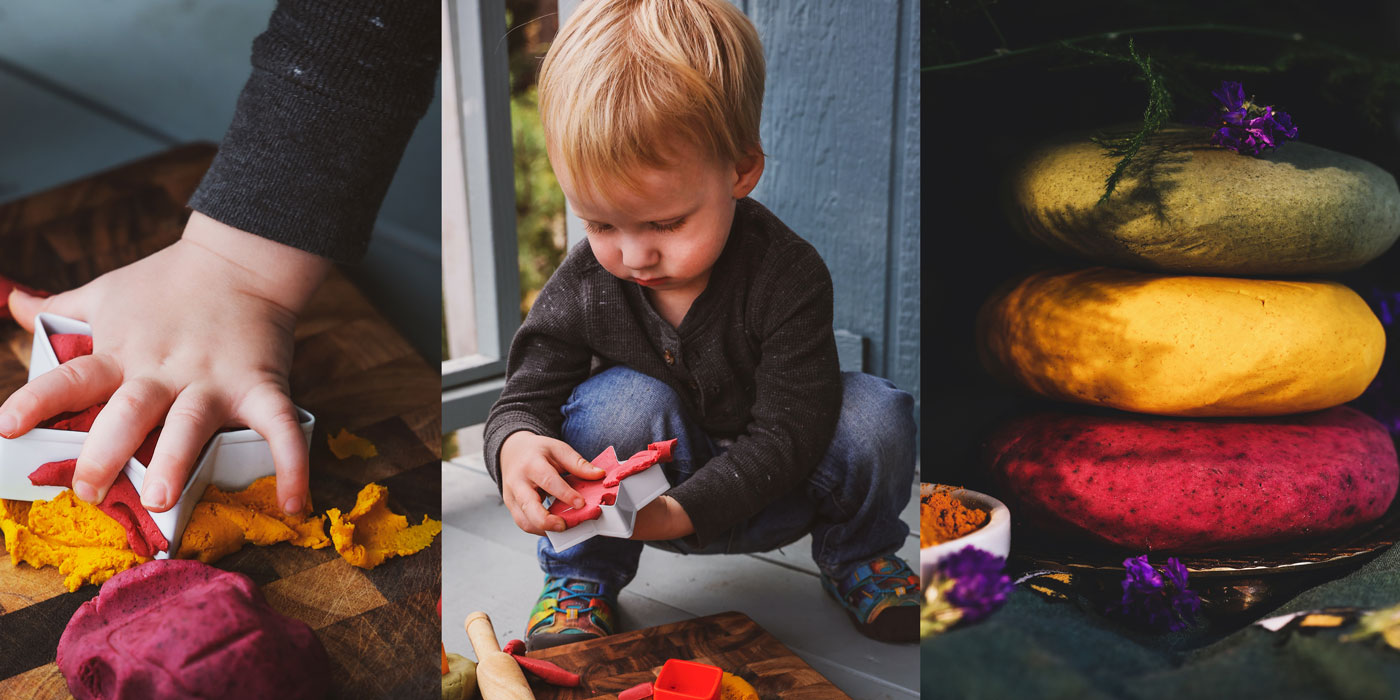This homemade playdough recipe makes about 5 ounces. The best way I’ve found to make multiple colors of playdough in one session is to set out individual bowls of the premixed dry ingredients, each with a different color herbal powder. Set some water on to boil. Then it’s easy to make a production line. Once you’re set up, it takes about 10 minutes per bowl to complete, including the kneading.

Ingredients
- 1/2 cup all purpose flour plus more as needed
- 2 tablespoons fine sea salt*
- 1 1/2 teaspoons cream of tartar (To substitute for the cream of tartar in homemade playdough, you will need to use 1 teaspoon white vinegar or lemon juice for every 1/2 teaspoon cream of tartar.)
- 2 to 4 teaspoons organic herbal powders* of choice, or more as necessary to achieve color
- 1 1/2 teaspoons melted organic coconut oil*
- About 1/3 cup boiling water
- 1/4 to 1/2 teaspoons culinary extract to add subtle aroma (optional) — we like almond extract
- Organic arrowroot powder* for finishing (optional)
Directions
- In a bowl, thoroughly whisk together the flour, salt, cream of tartar, and herbal powder of choice.
- Drizzle in the coconut oil and whisk to incorporate.
- Pour in boiling water. Using a rubber spatula, combine ingredients. Add a little more herbal powder for more color.
- Use the spatula to continue incorporating the last of the flour. If dough is too dry, add more boiling water 1 tablespoon at a time. If dough is too wet, you can knead in more flour in the final step.
- Add optional extract for aroma and work into dough with rubber spatula.
- Knead dough on a lightly floured surface to incorporate a little more flour and create a soft, smooth dough. It may be a tiny bit sticky still.
- To finish dough, I find kneading in a little arrowroot powder gives a perfect consistency and takes away any final stickiness. Continue kneading for a couple more minutes to fully incorporate dough ingredients and improve texture.
- Put into a sealed plastic bag or glass container for storage in a cool place. Unrefrigerated dough, stored correctly, is shelf stable for about one month but refrigerating will increase shelf life. Dough should be discarded and composted when it begins to change texture or smell off. I suggest refrigerating this dough if you used white vinegar or lemon juice as a substitute for the cream of tartar. The vinegar or lemon juice does change the smell of this dough. Both the arrowroot powder and adding an extract can help.
Pro Tips
- If you want a larger batch of a single color, this recipe scales up easily. I find that working with as much as two cups of flour at a time is still easy for adult-size hands, but a little trickier for kids.
- If a playdough-lover needs to steer clear of gluten, you can make this recipe with a one-to-one style gluten-free flour. Different brands produce different results, so you may need to experiment to achieve the best texture.
- Some people use essential oils to add stronger aroma to playdough, but I have a personal “absolutely not” rule about using essential oils with babies and toddlers, hence the culinary extracts in this recipe.
- If playdough starts to dry out with time and use, but doesn’t smell like it’s going off, you can often revitalize it by very lightly dampening a rag and wrapping it around the dough. Put the dough and rag in a ziplock and let them sit for a couple hours then re-knead the dough. Repeat if necessary.
Here are some wonderful organic, food-safe herbal powder options to get you started on coloring homemade playdough:
Reds and pinks: beet root*, cranberry*, rosehip*
Oranges and yellows: turmeric root*, safflower*
Greens: kale*, spinach*, nettle leaf, rosemary leaf*, spirulina*
Blues and purples: Acai berry*, hibiscus flower*
Browns: cacao powder*, black teas*
*These high-quality, organic ingredients can be found at the Mountain Rose Herbs Mercantile located at 152 W. 5th Ave. or online at mountairoseherbs.com.


